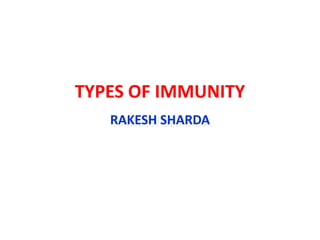
Types-of-Immunity.ppt
- 1. TYPES OF IMMUNITY RAKESH SHARDA
- 2. Overview of the Immune System Immune System Innate (Nonspecific) Adaptive (Specific) Cellular Components Humoral Components Cellular Components Humoral Components
- 3. Innate immunity refers to an immediate or early antigen-nonspecific defense mechanisms that are present in a host since birth without being induced and are designed to react and/or eliminate any antigen. This is the immunity one is born with Adaptive (acquired) immunity refers to antigen- specific induced defense mechanisms that take several days to develop and are designed to react and/or eliminate a specific antigen. This is the immunity one acquires during life. (Adaptive immunity is found exclusively in vertebrates) Components of the Immune Syste INNATE versus ADAPTIVE IMMUNITY
- 4. The innate immune responses involve: physical barriers chemicals - lysozyme, bile salts, sebum, HCl acid, etc cells that release inflammatory mediators phagocytic cells natural killer cells humoral factors - complement proteins, acute phase proteins, and cytokines. Innate Immunity
- 5. The Adaptive immune responses involves: antigen-presenting cells (APCs) such as macrophages and dendritic cells; the activation and proliferation of antigen-specific B- lymphocytes; the activation and proliferation of antigen-specific T- lymphocytes; the production of antibody molecules, cytotoxic T- lymphocytes (CTLs), and cytokines. Adaptive Immunity
- 6. Innate Immunity Adaptive Immunity Components of Innate and Adaptive Immunity skin, gut Villi, lung cilia,etc many protein and non-protein secretions phagocytes, NK cell eosinophils, K cells physical barriers soluble factors cells none Immunoglobulins (antibody) T and B lymphocytes APCs
- 7. Skin GIT Innate Immunity Physical barrier ----- ----- ----- ----- ---- ----- ------- -------- ---- ---- ---- --- ----- ----- Chemical barrier ----- ----- ----- ----- ---- ----- ------- -------- ---- ---- ---- --- ----- ----- Sweat, Sebum, Tears (body toxic fluids) Antigen/ foreign material + Cellular barrier Phagocytosing cells II Line of defense Acquired Immunity I Line of defense III Line of defense B T Antibody Antibody-mediated Immunity Cell Mediated Immunity Y Y Y Y Y Antigen elimination
- 8. CARDINAL FEATURES OF ADAPTIVE IMMUNE SYSTEM 1. Tolerance to self antigens - under normal conditions, an immune response to "self" antigens (called an autoimmune response) does not occur. 2. Specificity – components of adaptive immunity react specifically with the antigen that induced their formation. 3. Memory - the adaptive immunological response remembers the antigen for invariable period of time and upon subsequent exposure to homologous antigen there is an anamnestic immune response, i.e. strengthens upon repeated exposure
- 9. Innate Immunity Adaptive Immunity Characteristics/Differences of Innate and Adaptive Immunity No Immunologic memory Antigen independent No time lag Not antigen specific Antigen dependent A lag period Antigen specific Development of memory
- 11. Classification of Adaptive Immunity Adaptive Immune System Basis of Effecter molecules Basis of mode of development Humoral immunity Cell mediated Immunity Active Immunity Passive Immunity
- 12. Types of Acquired Immunity (On the basis of effector molecules) Humoral immunity: Humoral or antibody mediated immunity (AMI) is characterized by the production of antigen- specific immunoglobulin molecules, called as ‘antibodies’, induced in response to an antigen and is mediated by B- lymphocytes. Antibodies primarily defend against extracellular pathogens and toxins. Humoral immunity is so named because it involves substances found in the humors, or body fluids. Cell-mediated immunity: Cell-mediated immunity (CMI) involves the activation of antigen-specific cells, such as CTLs and macrophages, which destroys the cells harboring antigen. Cellular immunity primarily defend against intracellular pathogens, multicellular parasites, transplanted tissue, and cancer cells.
- 13. Humoral Immunity Cell mediated Immunity Characteristics/Differences of Humoral and Cell mediated Immunity Effective against extracellular parasites B-cell dependent Effecter molecule - antibodies T-cell dependent Effecter – CTL, NK, macrophages Effective against intracellular parasites, tumor cells, tissue grafts MHC restriction: +/- MHC restriction:+
- 15. The Interrelation of AMI and CMI 1. Th cells activate B cells to produce antibodies against T-dependent antigens (usually protein in composition). 2. In antibody-dependent cell-mediated cytotoxicity (ADCC), NK cells, macrophages, and other leukocytes lyse antibody-coated cells that are too large to be phagocytosed.
- 16. Types of Acquired Immunity (On the basis of mode of development) Active immunity, in which the host develops an adaptive immunological response and produces the cells and factors responsible for the immunity. Active immunity can persist for a long time in the host. Passive immunity is acquisition by a host of immune factors which were produced in another animal, i.e., the host receives pre-formed antibodies and/or immuno- reactive lymphocytes. Passive immunity is typically short-lived and usually persists only a few weeks or months.
- 17. INFECTION OF “ X” MILK (COLOSTRUM) “ACTIVE IMMUNITY ” “ PASSIVE IMMUNITY “ MOTHER NEWBORN ANTIBODIES TO “X” ARE PRODUCED Resistance
- 18. Active Immunity Passive Immunity Characteristics/Differences of Active and Passive Immunity Lag period Titer is time dependent Participation of hosts’ immune system Long lived Memory No participation Short lived No memory No lag period Immediately high titer
- 19. Types of Active & Passive Immunity Active immunity Passive immunity Natural (e.g. infection) Artificial (e.g. vaccination) Natural (e.g. maternal Ab) Artificial (e.g. Hyper immune Serum)
- 21. Advantages Disadvantages serum sickness immediate protection no long term protection graft vs. host disease (cell graft only) risk of hepatitis and Aids Advantages and Disadvantages of Passive Immunization